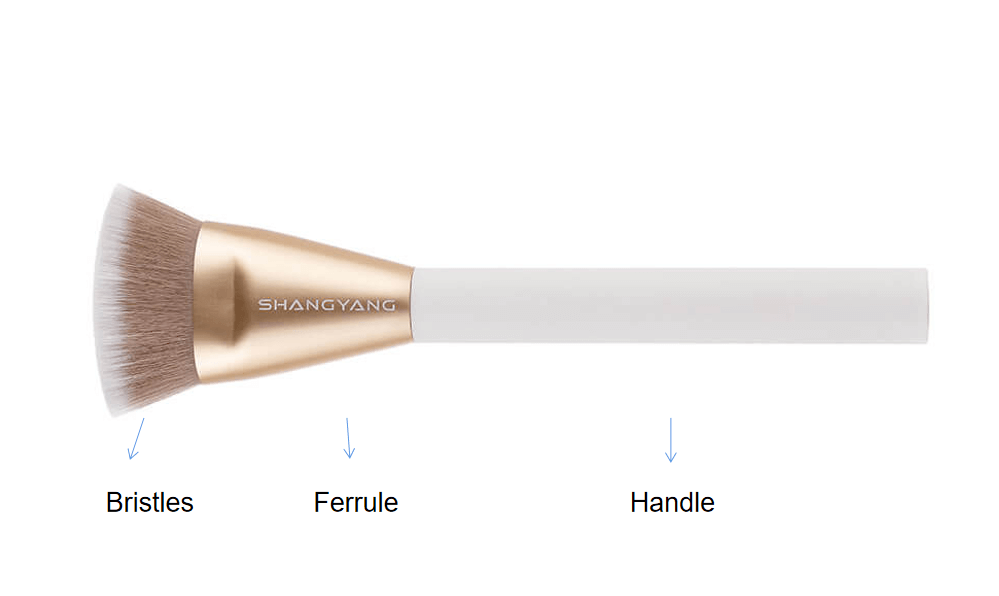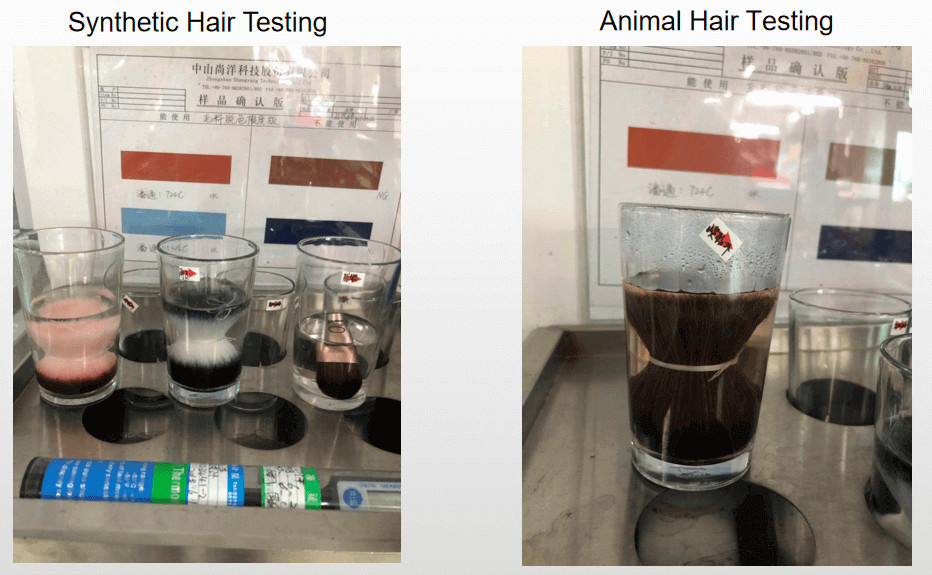Have you ever stopped to wonder what makeup brushes are made of? From synthetic to natural fibers, wooden handles to metal ferrules, each element plays a significant role in the performance and longevity of your brushes. In this article, we will delve into the three main components of a makeup brush—the handle, the ferrule, and the bristles—and discuss the materials commonly used for each.
A brush consists of three parts: bristles, ferrule, and handle.

1.The Handle
The handle of a makeup brush is typically made from one of the following materials:
- Wood: Traditional, durable, and luxurious. Wood handles are often coated to prevent damage from water and cosmetics.
- Plastic: Lightweight and cost-effective, plastic handles are easy to clean but may not be as durable as other options.
- Metal: Usually made of aluminum or stainless steel, metal handles are durable and give the brush a sleek look.
- Bamboo: An eco-friendly option, bamboo handles are biodegradable and sustainable, though they can be prone to cracking if not properly cared for.
While bamboo has long been the go-to material for eco-friendly brush handles, Some companies, for example, ShangYang, developed other sustainable alternatives,such as Tea Fiber Plastic Handle ,Coffee Grounds Handle,Sawdust Wood Plastic Handle.

2.The Ferrule
The ferrule is the metal piece that connects the handle to the bristles. It is generally made of one of the following materials:
- Aluminum: Lightweight and cost-effective, but may be prone to bending.
- Nickel-Brass: More durable than aluminum and corrosion-resistant.
- Stainless Steel: Premium quality, durable, and resistant to corrosion.
3.The Bristles
3.1 Synthetic Bristles
Synthetic bristles are usually made of materials like nylon, polyester, or Taklon. These bristles are:
- Vegan-Friendly: No animal hair is used.
- Hypoallergenic: Less likely to cause allergic reactions.
- Easy to Clean: Less porous than natural hair, making them less likely to harbor bacteria.
3.2 Natural Hair Bristles
Natural hair bristles are commonly sourced from animals like sable, weasel, squirrel, or goat.
3.3 Common Animal Hair Types In Makeup Brushes
Mink Hair (Also Known As Yellow Weasel Hair)
This type of animal hair is considered premium in the brush industry. It is elastic and has a moderate softness, making it perfect for various makeup applications.

Weasel Hair
Similar to mink hair, weasel hair is another top-quality animal hair. It possesses a soft yet durable texture suitable for high-end brushes.

Horse Hair
Horse hair is harder than goat hair and is commonly used in eyeshadow brushes for more precise application.

Goat Hair
The most prevalent type of hair used in makeup brushes, goat hair, is soft and durable. It’s versatile and can be used for various types of makeup application.

Squirrel Hair
While less expensive than mink hair, squirrel hair is highly soft and often used for applying powders.

Badger Hair
Badger hair has a firm yet moderate texture, making it ideal for eyebrow brushes. It allows for moderate coloring without making your eyebrows look overly intense.

Other Animal Hair
Other animal hairs include otter, cow’s ear, pig, rat, ostrich, and turkey. These are less common but still find their way into specialized brushes.The commonly used animal hairs in the market are goat, horse, and yellow weasel (mink).
The makeup brush market is filled with a wide array of brush bristles, each with unique qualities and functions. From animal hair to synthetic fibers, knowing the distinctions can help you make an informed choice. Below is an extended look at common animal hair types, synthetic fibers, and how to distinguish between the two.
4. How To Distinguish Between Natural Hair And Synthetic Hair?
4.1 Animal Hair
- Look: It is flammable and produces a flame when set on fire.
- Smell: It emits a smell similar to burnt human hair when set ablaze.
- Touch: The ash produced after burning crumbles easily when pinched.
4.2 Synthetic Hair (Nylon)
- Look: Difficult to ignite and doesn’t produce a flame; it melts into a lump.
- Smell: When melted and recrystallized, it doesn’t emit a smell. However, prolonged burning results in a plastic odor.
- Touch: If it recrystallizes, it will feel hard when pinched. If burned, it will automatically melt and leave no ash.
4.3 Synthetic vs. Natural Hair Brushes
- Cost: Synthetic brushes are generally cheaper than natural hair brushes.
- Application: Natural bristles are often preferred for powders, while synthetic bristles excel in applying creams and liquids.
- Maintenance: Natural bristles require more frequent and careful cleaning.
4.4 Improved Synthetic Fibers
To enhance the powder-capturing ability of synthetic fibers, some companies, for example, ShangYang have developed specialized synthetic fibers. These innovations focus not only on softness but also on mimicking the natural scales found in animal hair for better powder application. Additionally, features like antibacterial properties, Vitamin C infusion, negative ions, and microcrystalline fibers have been added for extra functionality.
These advanced synthetic fibers offer numerous advantages, such as:
●Improved powder absorption
●Allergy resistance
●Uniform powder application
●Strong powder grip
●Soft and comfortable texture
●Moderate elasticity
These qualities make it easier for makeup novices to use them. Functionally, they surpass ordinary synthetic fibers and achieve a performance standard comparable to animal hair while being more eco-friendly.

5. Eco-friendly and Cruelty-free Options in Makeup Brushes
1. Synthetic Bristles: Opting for synthetic bristles is a surefire way to choose a cruelty-free brush.
2. Bamboo Handles: These are biodegradable and sustainable.
3. Recycled Materials: Some brands offer brushes made from recycled plastics.
4. Certifications: Look for brushes that have cruelty-free and vegan certifications.
6. Introducing ShangYang: Pioneering Eco-Friendly Innovations in Makeup Brushes
At ShangYang, we believe that sustainability and performance should go hand-in-hand. Whether you’re a makeup novice or a seasoned artist, our brushes offer unparalleled functionality without compromising on your commitment to protecting the environment.

Why Choose ShangYang?
1. Innovative: With over 160 patents, we are pioneers in the industry, always striving for the next groundbreaking idea.
2. Eco-friendly: From our bristles to our handles, every component is crafted with sustainability in mind.
3. High Performance: Our brushes are designed to provide a seamless makeup application experience, rivaling even the finest animal hair brushes in the market.
4. Variety: Our range of handle materials offers something for everyone, letting you pick a brush that aligns with both your makeup and environmental needs.
5. Ethical: We believe in ethical manufacturing practices that benefit not just our consumers but also our planet.
By choosing ShangYang, you’re not just investing in a high-quality makeup brush; you’re also contributing to a more sustainable and ethical future for the beauty industry. Contact us in making a difference—one brush at a time.





